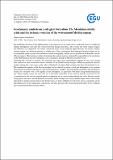Por favor, use este identificador para citar o enlazar a este item:
http://hdl.handle.net/10261/149961COMPARTIR / EXPORTAR:
 SHARE
BASE SHARE
BASE
|
|
| Visualizar otros formatos: MARC | Dublin Core | RDF | ORE | MODS | METS | DIDL | DATACITE | |

| Título: | Geodynamic controls on a salt giant formation. The Messinian salinity crisis and the tectonic evolution of the westernmost Mediterranean |
Autor: | García-Castellanos, Daniel CSIC ORCID | Fecha de publicación: | 17-abr-2016 | Editor: | European Geosciences Union | Citación: | Geophysical Research Abstracts Vol. 18: EGU2016-14394 (2016) | Resumen: | The landlocked location of the Mediterranean is presumed to be the result of the southward retreat of subducted Tethyan lithospheric slabs after the collision between Europe and Africa. The western end of the Alpine orogeny (the Gibraltar Arc) shaped the last marine connection to the ocean during the upper Miocene, but in this complex tectonic region, the dominant polarity of subduction (Tethys underneath Iberia/Europe/Anatolia) might not be accomplished, based on plate reconstructions, mantle tomography, and the present position of the Kabylies and the Alboran nappes. This tectonic evolution determined the vertical motions purportedly responsible for the restriction of the Mediterranean and the widespread salt accumulation during the Messinian Salinity Crisis. Following the concept of isostasy, the enormous and rapid mass redistribution implied by the crisis should have induced in turn remarkable vertical motions of the Mediterranean margins. While the predicted isostatic motions during the crisis range in the order of hundreds of meters, little evidence has been documented so far.The mechanical response of the Iberian margins can be inferred by using crustal and lithospheric cross sections derived from potential fields (gravity and geoid anomalies), heatflow, and topography modeling. The preliminary results are consistent with a low rigidity of the lithosphere, in agreement with their young thermomechanical age. These rigidity values are then used for a first-order estimation of the vertical motions associated to the accumulation of salt and the possible partial evaporation of the water column during the crisis. Recent seismic stratigraphic data show that the Balearic promontory hosts a unique set of intermediate-depth basins where halite deposited in smaller amounts than in the deeper basins. If future drillings provide more precise constraints on the paleobathymetry of the sedimentary units before and after the crisis, the various proposed models for its evolution may be tested from their isostatic effects. | URI: | http://hdl.handle.net/10261/149961 |
| Aparece en las colecciones: | (Geo3Bcn) Comunicaciones congresos |
Ficheros en este ítem:
| Fichero | Descripción | Tamaño | Formato | |
|---|---|---|---|---|
| Garcia-Castellanos_EGU2016-14394.pdf | 35,25 kB | Adobe PDF |  Visualizar/Abrir |
CORE Recommender
Page view(s)
147
checked on 18-abr-2024
Download(s)
49
checked on 18-abr-2024
Google ScholarTM
Check
Este item está licenciado bajo una Licencia Creative Commons

